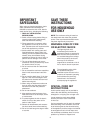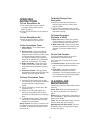9
• For whipping egg whites, both the mixing
bowl and chef’s whisk must be spotlessly
clean and dry. Any trace of fat or oil will
prevent the egg whites from whipping
properly.
• To check the freshness of eggs, place
them in a bowl of warm water – if they
float, they are not fresh.
• To melt chocolate for a recipe, place
chopped chocolate in a double boiler
insert or larger bowl over a pan of barely
simmering hot water. The water should
not boil, nor should it touch the bottom of
the double boiler insert or bowl. If it does,
this could cause the chocolate to “seize”
and you will not be able to use it in your
recipe.
• Always test yeast for freshness before
using it in a recipe. Sprinkle a little over
warm (105-110°F) water from recipe and
add a pinch of sugar or flour from the
recipe. If it does not become foamy/
bubbly in 5 to 10 minutes, the yeast may
be “dead.” Start over with fresh yeast
from a new package.
• For mixing yeast doughs, begin by using
the flat mixing paddle. When starting a
recipe, dough is thinner and more like
a batter and mixes more efficiently and
smoothly with a paddle. After a very thick,
smooth batter forms, switch to the dough
hook to complete the recipe.
COOKIE BAKING
• Use an ice cream scoop to measure out
cookie dough – this keeps the cookies
evenly shaped and uniform in size. We
recommend ice cream scoops in several
sizes – #’s 40, 50 and 60, as well as a
larger one (about
1
⁄
3
to ½ cup) for jumbo
cookies. Ice cream scoops, also known
as “dishers” are also good for filling
muffin tins. Use a #16 ice cream scoop to
make muffins or meatballs.
• To better maintain cookie shapes, put
scoops of cookie dough onto sheets of
waxed paper or plastic wrap on a tray and
chill before baking. Most cookie dough
can be refrigerated for 2 to 3 days prior to
baking – be sure to wrap well.
• Cookie dough may also be frozen. Shape
into individual cookies, double wrap and
freeze for up to 3 months.
• Line baking sheets with parchment for
easy release and easy cleanup.
• Let cookies rest on sheets for 2 to 3
minutes before removing them to a wire
rack to cool. This keeps cookies from
wrinkling, crumbling or breaking.
• Cookies must cool completely before
being put into storage containers to avoid
them becoming soggy and misshapen.
BREAD BAKING
• One ¼-ounce packet of yeast equals
2¼ teaspoons yeast.
• Using milk in place of water will produce a
softer crust.
• After baking, you can soften the crust, if
desired, by rubbing it with unsalted butter
soon after removing it from the oven. This
prevents it from drying out too quickly.
• If a recipe calls for a specific type of flour,
used the flour recommended. If you do
not have bread flour, you can substitute
unbleached, all-purpose flour, but your
bread may not rise quite as much.
• Do not use “lite” or tub margarines for
bread baking – the first ingredient is often
water and they do not work well in any
baking.
• Vital gluten is the dried protein taken from
the flour by eliminating the starch. It is a
good dough conditioner or enhancement
for yeast breads, especially for whole
grain breads or when using all-purpose
flour. If a recipe specifically calls for vital
gluten, we recommend that it be used for
best results.
• For 100% whole wheat bread use 1½
teaspoons vital gluten per cup of flour.
• Lite salt can be used if it has both
potassium chloride and sodium.
• Many bread recipes have a “range”
amount of flour – start by using the lower
end of the range, then add more flour as
needed to produce a smooth, not sticky
dough.
• Before measuring molasses or honey,
oil the measuring spoon to help it run
off better.
• To produce a higher loaf of bread, use
water that potatoes have been cooked in.














